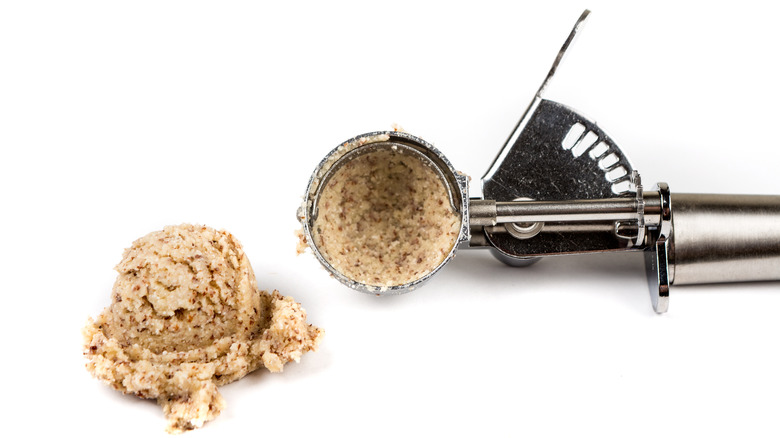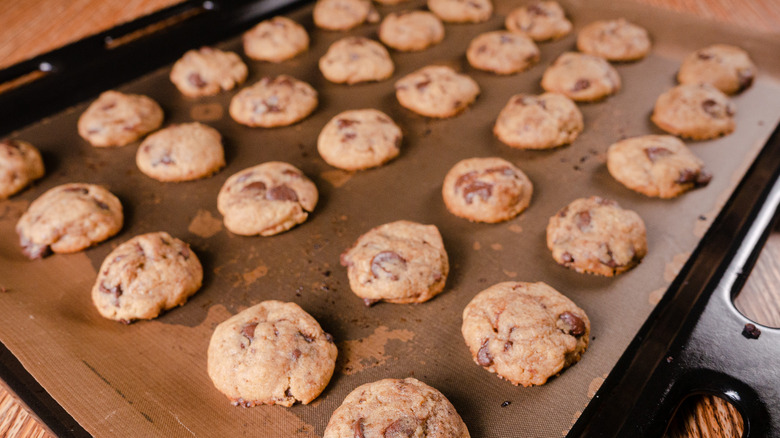Ina Garten's Pre-Portioned Cookie Dough Relies On One Kitchen Tool
There are a few ways to get bakery-level cookies in your home kitchen, and Ina Garten's trick for pre-portioned cookie dough is the first step. When it comes to baking, uniformly portioning the cookie dough is critical to ensure all the cookies look the same and cook evenly, eliminating an undercooked and burnt cookie on the same baking sheet.
Cookie recipes are either written precisely using a scale to measure grams of cookie dough or vaguely instructing bakers to make "rounded tablespoons of cookie dough," leaving room for inconsistencies. Acknowledging that not every home cook has a kitchen scale, Garten uses a tool most of us have: a standard 2 ¼" ice cream scoop to measure cookie dough for large, uniform cookies.
Not only can this ensure each cookie receives the same amount of dough, but the technique can also be used to pre-portion other ingredients eliminating the guesswork from recipes.
Use an ice cream scoop for perfect cookies
For this tip, Ina Garten uses the type of ice cream scoop with a spring-loaded sweeper bar, not the old-fashioned, one-piece oval models. To maintain consistent portions, fill the scoop's bowl with dough. Then, using the lip of the container or your hand, scrape off any excess dough from the scoop. Once done, place the dough onto the cookie sheet.
Please limit the number of cookies per tray to keep them from baking into one massive, undercooked cookie. While it will vary per recipe and whether the dough is properly chilled, a standard half-sheet pan or cookie sheet using a 2 ¼" scoop should have no more than six cookies, less if the cookie dough is warm or spreads a lot like tuiles.
Most cookies need about two inches to spread, allowing air to circulate and bake evenly. Rather than overcrowd the pan, it's better to use multiple baking sheets or bake the cookies in stages. Still, cookies may blend if the pan is warped or your oven temperature is uneven, but we can fix that.
As soon as the cookies come out of the oven, position a cup or mason jar lid over any misshapen pieces. Move your hand in a circular motion to gently mold the edges, reshaping them into a flawless round shape. Any round container can be used as long as it's larger than the cookie. Unfortunately, this trick won't work once the cookies cool, so act quickly.
Different sized ice cream scoops and uses
Not all ice cream scoops are designed equally. The sweeper bar often breaks on cheaper models, and the scoop diameter can vary between manufacturers.
A standard restaurant ice cream scoop is sold as a #16 scoop (corresponding to the number of scoops you'd get from a quart of ice cream). It measures one-quarter cup of cookie dough and is also helpful for portioning muffins and cupcake batter. This size is suitable for shaping large meatballs for Sunday's gravy meat or effortlessly scooping the seeds from squash.
Ice cream scoops come in a dozen sizes ranging from the smallest, #100, to a giant, #4, which has a 3 ⅝″ diameter. Although slightly confusing, the higher the number, the smaller the scoop. While most home cooks don't need that many options, having two or three can be helpful.
For mini cupcakes or smaller cookies, bakers should use a #60, which will consistently deliver one tablespoon of batter or dough. And if bite-sized chocolate confections are something you enjoy making, keep a #100 scoop to make truffles.



